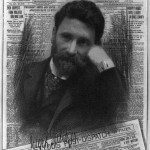Old nine vs. New six
The title of this cartoon was “Furnish the Court…Assistant”, which was published on 2/6/37,by Elderman in Washington. This cartoon responded to the Judicial Procedures Reform Bill of 1937, also known as Court packing plan. His purpose was to regulate the New Deal legislation that was ruled unconstitutional before. According to the plan, the President could nominate maximum of six Justices to the Supreme Court.
The six people on the top were the Justices that nominated by Roosevelt and those nine people were the old Justices. Those nine Justices looked serious and those six were not. I think the cartoonist tried to imply those six were just listen to President and support every decisions made by Roosevelt. So they were not taking thing serious.




 \
\
 I am not sure when this cartoon was published, but it looks pretty old. It was published in the Pittsburgh Press. This cartoon took a play on the word ‘Deal.’ In this cartoon we see a poker hand of 4 Aces and a King. In poker that is 4 of a kind, a great hand. I think the author is praising the New Deal. He is saying that it is really great, just like the poker hand. The title says “It IS a New Deal,” probably referring to a “new hand” after the Great Depression. This hand is a winner, showing how the author praises the New Deal.
I am not sure when this cartoon was published, but it looks pretty old. It was published in the Pittsburgh Press. This cartoon took a play on the word ‘Deal.’ In this cartoon we see a poker hand of 4 Aces and a King. In poker that is 4 of a kind, a great hand. I think the author is praising the New Deal. He is saying that it is really great, just like the poker hand. The title says “It IS a New Deal,” probably referring to a “new hand” after the Great Depression. This hand is a winner, showing how the author praises the New Deal.



